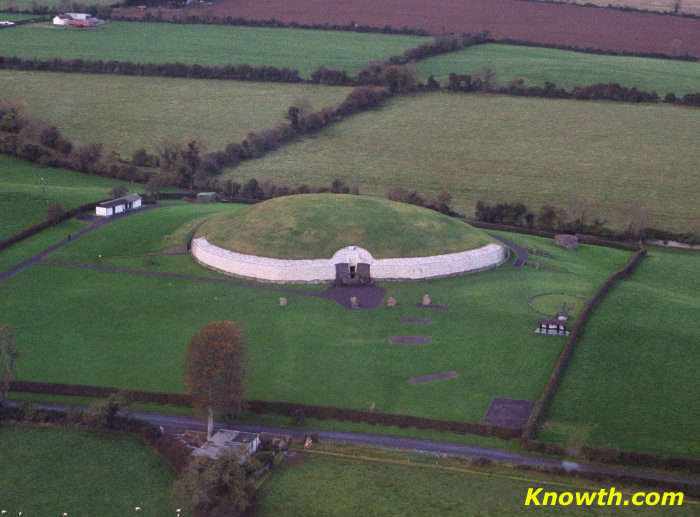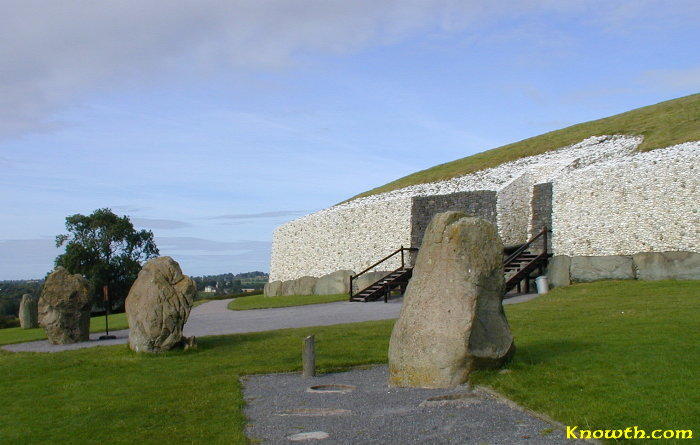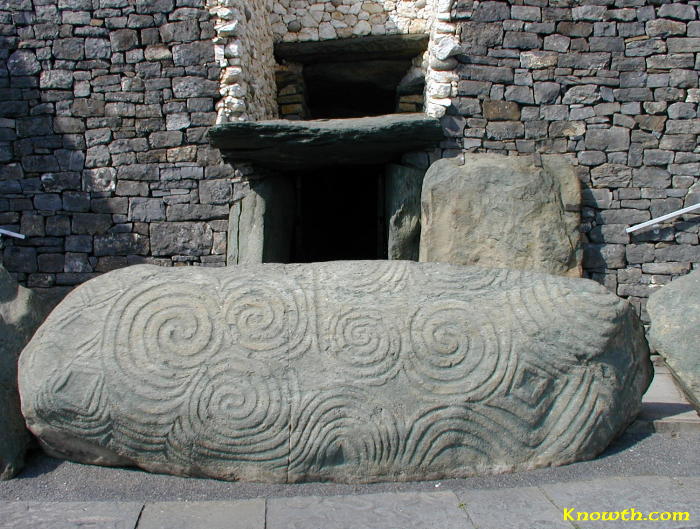Newgrange
The first sight to impress me at Newgrange was the candy counter in the gift shop. They had grape flavored suckers with gum in the middle. I tried one. It was a delicious burst of grape in my mouth. It was like a tootsie-roll pop, but with gum in the middle. Savoring the tooth-dissolving treat reminded me of the old commercial of a wizened and wise old owl being interviewed by a goofy-looking kid. "Owl, do you know how many licks it will take to get to the center of a tootsie-roll pop?" The owl sagely takes the sucker and performs an experiment. Licking the treat, he counts each stroke of his tongue aloud. "One, t-hoo, three…" At this point, he can no longer stand the lure of the candy and must bite into it to get at the rich, tootsie-roll center. "Three," he declares with authority and pomp. The announcer's voice, deep and calming, philosophizes, "How many licks does it take to get to the center of a tootsie-roll pop? The world may never know…." Now, back to our regularly scheduled journal entry:
The next thing to impress me at Newgrange was a beautiful etched-glass swirl, looking out onto the Boyne Valley. The swirl was the color of sleet against the fertile emerald valley and powder-blue sky. The window looked out from the visitor center to the small footbridge that led to the museum's bus station. There, visitors hopped on buses to the ancient structure of Newgrange.
It isn't every day that I can set foot on a site inhabited by humankind since before the pyramids. This is one such site. It's probably Europe's most impressive prehistoric monument. Unlike the fenced-in and sanitized site of Stonehenge, Newgrange allows visitors to traipse in and touch the site. So what is Newgrange? I guess I should have started out with that information rather than that lame nostalgic trip down into candy land.


Newgrange is a massive grass-covered biscuit-shaped mound about 80 meters (88 yards) in diameter and 13 meters (14 yards) high. It's situated in County Meath, about a half-hour's drive north-northwest from Dublin.
The monument predates the pyramids of Egypt by about 6 centuries. It's a Neolithic structure that is remarkably well preserved. Inside the monument is an elaborate chamber, probably used for ceremonial burial. But that's just conjecture -- no one really knows what it was used for.
One thing is certain: on the winter solstice, at 8:30 am, the rising sun pours its magnificent golden light through the perfectly aligned slit above the entrance. The radiant light spills slowly down the passage until it reaches the tomb chamber for 17 glorious minutes. Our guide, a baby-faced college student named Jason, demonstrated the effect of sunlight with an elaborate demonstration with artificial lights. Even though it was a paltry substitute for the real thing, it was still a spectacular sight. And it helped us envision what the actual sun would look like on that special day every year. Jason had worked there for more than a year and had been treated to the view the previous year. "It's beyond words – the feeling you get from it," he related. "The waiting list is decades long, so I felt lucky to see it," the shy physics student told me with a twinkle in his eye.
Just outside the entrance is a massive boulder called a kerbstone. It is one of 97 that encircle the mound and keep the 200,000 tons of dirt and stone in place. The stone at the front of Newgrange is special, though. It has the most elaborate and the most ornate carvings of any of the stones.
Most impressive about it is the iconic triple spiral pattern. It's composed of three single-line spirals that in intersect. Staring at this beautiful, perfectly balanced symbol, I suddenly realized that I'd seen it before. The toes of the Great Buddha often have the exact same pattern. The Buddha's feet were lovingly etched in brass and gold plate, whereas the Newgrange swirls were painstakingly carved from stone. That's why the Newgrange version was a little rougher and weather-beaten. But it was the same pattern, no mistaking it.
What does the triple-swirl mean? Jason supplied us with a few interpretations: "No one really knows what they mean, but many have offered their theories. Some say that the swirls could represent the father, the mother and the child, or they could symbolize birth, life and death. Still others contend that the swirls are simply a depiction of a common visualization from hallucinogenic mushrooms that still grow in the valley today."
I have to admit that the last explanation was my personal favorite, based on pharmacological research I conducted in Amsterdam a few years ago. Here's why: the mound was constructed by people obviously concerned about the other world (death) and about connecting themselves, however tenuously (only one day a year) to it. How else, other than through a shaman's other-worldly pharmacopia, would you be able to connect with the other side on a regular basis? And besides, I saw plenty of swirls during my experiments in the coffee shops and among the canals of the Dutch capital.
The mystery of the meaning of the swirls is engaging, but another one perhaps overshadows it. The builders of the monument are called the Beakers – a cute but annoying name based on their tendency to bury their dead with drinking vessels. The Beakers had to have amazingly precise instruments to measure all of the angles and alignments for the tomb. They also had to have mathematical proficiency enough to figure the calendar so precisely. According to careful surveys of the tomb, scientists have discovered that the Beakers were more sophisticated, mathematically and in planetary physics, than the Greeks. If that was the case, then why aren't there more examples of their impressive KSAs (Knowledge, Skills and Aptitudes)?
The answer to these mysteries is much like the mystery of the tootsie-roll pop: the world may never know.


0 Comments:
Post a Comment
<< Home